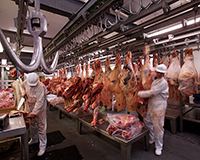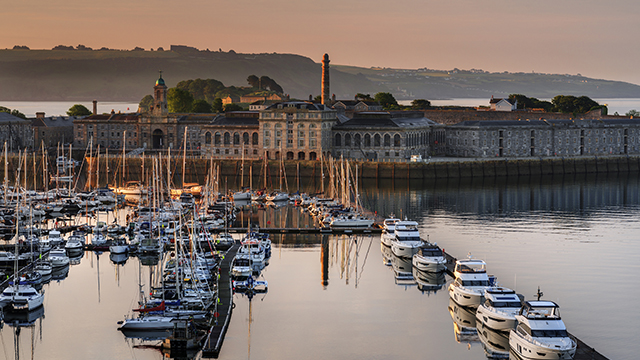Smithfield Market’s regeneration
Smithfield may be one of London’s most misunderstood locations. As local experts such as Colliers International’s Shaun Simons are quick to point out: “Smithfield is part of the Clerkenwell market, it’s not a submarket in itself. That would be like suggesting Wardour Street is separate from Soho.”
Although there are roads named West Smithfield and Smithfield Street, the term is usually applied to the impressive Victorian market buildings flanked by Charterhouse Street to the north and Long Lane to the south.
There is confusion about these buildings, too. The eastern-most one houses the Grade II listed Smithfield meat market – the capital’s last-trading major wholesale market. But the western ones, including the General and Poultry Market buildings, have been empty for decades.
Smithfield may be one of London’s most misunderstood locations. As local experts such as Colliers International’s Shaun Simons are quick to point out: “Smithfield is part of the Clerkenwell market, it’s not a submarket in itself. That would be like suggesting Wardour Street is separate from Soho.”
Although there are roads named West Smithfield and Smithfield Street, the term is usually applied to the impressive Victorian market buildings flanked by Charterhouse Street to the north and Long Lane to the south.
There is confusion about these buildings, too. The eastern-most one houses the Grade II listed Smithfield meat market – the capital’s last-trading major wholesale market. But the western ones, including the General and Poultry Market buildings, have been empty for decades.
Plans for the total demolition of the western market buildings were thrown out by the government in 2008, which also stepped in again in 2014 to halt Henderson Global Investors’ proposals for a £160m office and retail redevelopment behind retained façades. Years of uncertainty surrounding the future of such a large site has put the brakes on spin-off development that would normally accompany major redevelopment. Especially as the site is a chicken drumstick’s throw away from Farringdon’s nascent Crossrail station.
Finally, at the start of this year, a solution seems to have been found. The Museum of London will move into the western buildings, vacating its existing base in the Barbican. The £250m project will proceed thanks to turnkey funding of £70m from the mayor of London and £110m from the City of London Corporation. A planning application is expected next year, with the renovated Smithfield buildings expected to open in 2022.
[caption id="attachment_875004" align="aligncenter" width="570"] Smithfield, surrounded by Clerkenwell market[/caption]
Undergoing transformation
The corporation, which had its knuckles rapped by then-communities secretary Eric Pickles in 2014 for historically neglecting the fabric of the buildings, is now enthusiastically promoting the transformation of the site.
“We totally expect regeneration around Smithfield to happen,” says Carolyn Dwyer, the corporation’s director of the built environment. “We want to build on the existing cultural offer and create better accessibility, so new uses will come forward.”
How many of those will be traditional commercial property ones remain to be seen. “The fragmented pattern of property ownership and planning policies that are geared to preserving the historic character of the area provide fewer opportunities for large-scale regeneration projects,” says Michael Pain, head of London tenant advisory at Carter Jonas.
The effect that has had on Farringdon is demonstrated in office rents. Research from CBRE shows that these are hovering at £69.50 per sq ft, significantly lower than the £82.50 achievable in Fitzrovia, the submarket that includes the new Crossrail station at Tottenham Court Road. Unlike large office occupiers, smaller ones tend to make decisions about moving premises within a short timeframe and choose from existing buildings. This could work in Farringdon’s favour, says CBRE head of London research, Kevin McCauley. “So when Crossrail completes and people can see the impact on accessibility it will improve perceptions of the area,” he says.
Richard Garner, head of commercial agency at Daniel Watney, praises the City Corporation for protecting commercial uses near Smithfield, but argues that the local authority “needs to continue to engage and support office-led development in that location.”
London’s last big wholesale market: still the meat-ing place
Billingsgate, Covent Garden and Spitalfields are the well-known names of former London wholesale markets that have changed use since the second world war. Smithfield is unlikely to join them anytime soon. “The meat market will remain the meat market – we don’t anticipate it doing a Billingsgate,” says Alistair Subba-Row, senior partner at midtown specialist agency Farebrother.
The freeholder is the City Corporation. Caroline Dwyer, its director of the built environment, says that there are no plans to move the existing market. “Records show there has been a meat market there for 1,000 years, so it is important to celebrate that heritage,” she says.
Ironically the emphasis on heritage has delayed the very regeneration that can help to preserve historic areas. The comparison with nearby Crossrail station Tottenham Court Road is vivid. says: “You could have wiped out all the buildings on Tottenham Court Road and no one would have cared – that’s not the case with Smithfield.”
Leisure market: well connected
Although the rejuvenation of Smithfield by the Museum of London may have a questionable impact on the surrounding office market, the increased mass of a cultural quarter, linking to the existing Barbican Centre and the new Centre for Music concert hall, will undoubtedly boost leisure uses in the area.
Last summer, Whitbread won planning consent for a 326-bedroom Premier Inn on the site of the former City & Guilds Building on West Smithfield. Head of acquisitions Derek Griffin says: “Farringdon and Smithfield will be at the epicentre of a huge catchment area that many people have not fully appreciated until relatively recently.
“As a location and emerging market, Smithfield will be genuinely unique. I expect it will be something of a King’s Cross and Covent Garden mix – it will have some of the edginess of Clerkenwell, the influence of the City and a bit of a midtown feel too.”











